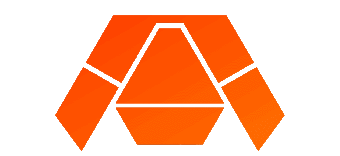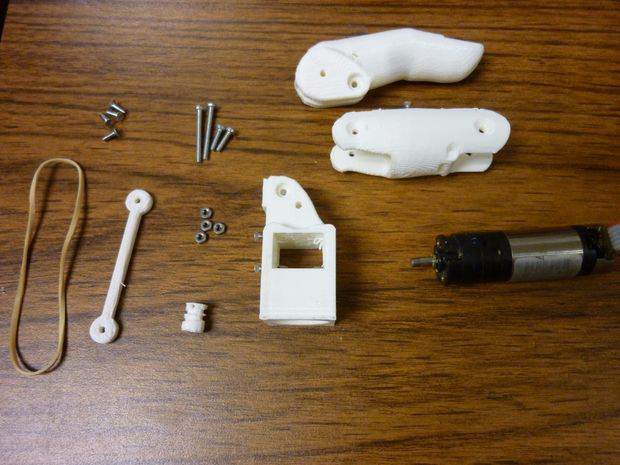Fall 2016 Prosthetic Hand: Mid-Semester Manufacturing Update
Design and Manufacturing Engineer – Wilson Mach
Table of Contents
Week 1: 8/28/2016 – 9/3/2016
The first week’s focus was to do research on which prosthetic hand would serve as the best base and straw man concept for this project. Research found that there are many open source prosthetic hands available that already have functioning mechanisms and 3-D printing .sdl or CAD files. As to not “start from scratch”, it proved most beneficial for us to start our research here rather than from physiological structures.
Combined research and collaboration within the group defined the straw man to be used as the “Tact Hand” by Instructables. This model was very useful as it provided necessary instructions and materials in order to build a prosthetic hand. However, it is never as simple as it looks and with this in mind, I delved into reading about the mechanisms of movement and assembly techniques that would be required of me in the impending manufacturing processes.
I needed to be aware of the physical capabilities, mechanical interfaces, and general structures of the hand model in order to adequately participate in the project and subsystem requirement building process to come. This knowledge was crucial to enhance “realizability” of the product in relation to the requirements and mission objective set forth. My insight into the mechanical limitations of the hand proved highly beneficial when constructing realizable goals for the project.
Finally, this week was also used to determine the most efficient and effective method of retrieving parts required. In order to combat any potential delays in shipping or problems with the parts, I was able to formulate a schedule based on part retrieval time as well as research multiple options for each required part. My research was based on the parts required for the Tact Hand, specifically. Using this knowledge, I was better able to predict when 3-D printing would be feasible and when a prototype could be created.
Figure 1 – Open Source Tact Hand from Instructables
Week 2: 9/4/2016 – 9/10/2016
The second week’s focus was to plan testing and verification on the Tact Hand mechanisms before believing in their reliability. After having researched the mechanical mechanisms and shipping details of parts, I was able to order the fastest and cheapest options for proof of concept testing. I anticipated that this testing would be crucial for the success of the project, should the group decide to move forward with designs based upon the Tact Hand.
The first step in doing this was learning how to use a 3-D printer. As this was my first experience working with one, I desired to learn as much as I could as fast as I could. Luckily, I was able to have access to multiple 3-D printers through the course professor, division manager, and a personal friend. The accessibility allowed me to train myself using a hands-on approach, which I would highly recommend to anyone learning to 3-D print.
Finally, as I was learning how to operate the 3-D printer, I researched materials associated with 3-D printing in order to determine the most appropriate material for the prosthetic hand. This research resulted in two potential filaments, ABS and PLA. In short, PLA is lighter and less dense than ABS. This results in faster printing time, but poorer quality sturdiness.
Figure 2 – PLA (left) vs. ABS (right)
Week 3: 9/11/2016 – 9/17/2016
The third week’s focus was to print one finger. I was able to acquire both the ABS filament that I desired as well as access to a 3-D printer. Since the Tact Hand provided .stl files, 3-D printing files, with parts already modeled, I was able to hit the ground running in regards to printing capability.
However, before printing, there were a few things that needed to be determined.
- I needed specific 3-D printing software for the printer; similar to a driver, this software is specific to the printer. This software would allow the .stl file to be loaded and modified before printing was to occur.
- I needed to determine the nozzle type to be used. The printer I used had 2 different nozzles which could be used separately or together with different filaments and colors.
- The model building orientation had to be determined. It is extremely important to have the flattest surface of the model to be placed on the platform to have a supportive foundation to any geometric shape atop it. Pieces that hang too far off of a base may become contorted. To combat this, auto supports need to be used when the nozzle prints without an existing base. Printing without this auto support yielded unusable prints that needed to be thrown away.
- Infill and printing time needed to be chosen carefully. Infill determines solidity and density of the final product. Since 3-D printers print one layer at a time, infill determines how much empty space there is within the final product. More infill would amount to more print time and more stability. As a base reference, an infill of 15% was able to complete half a finger in one hour.
At the end of this week, I was able to print out the 5 parts required to assemble one finger.
Figure 3 – One Finger Before Assembly
Week 4: 9/18/2016 – 9/24/2016
The fourth week’s focus was to assemble one finger and determine mechanistic problems. After having experimented with the 3-D printer, I moved onto acquiring other parts necessary such as screws, wires, and rubber bands. This were easily acquired at local hardware stores.
Connecting parts proved more difficult than anticipated as the connecting parts did not necessarily fit together perfectly. Some pieces and joints needed to be sanded down and cut off in order to fit together. In addition, some screw holes were missing from the printed model and needed to be drilled into the finger. Modifications were made to the 3-D printing file in order to accommodate problems along the way of assembling.
Some problems that were noted included grip capability and lack of ease of motion in the joint.
The following video explains the mechanical interfaces and design of the assembled finger.
Video – One Finger After Assembly
Week 5: 9/25/2016 – 10/1/2016
The fifth week’s focus was to learn about Solidworks.
However, before I moved onto learning about Solidworks, I manufactured a few fingers in order to provide the Electronics and Control Engineer, Younis Al-Kharusi, with some models to work with in regards to electronics, sensors, and actuators.
Solidworks is a CAD software that is used for modeling and manufacturing in 3 dimensions. The software includes many features including simulation and 3-D modeling from sketches. Solidworks allows edits of CAD files and .stl files. However, the size and complexity of the .stl files caused the software to allow for viewing but not editing capabilities. Multiple days were spent troubleshooting and trying to convert the .stl files to Solidworks files. If this would have been successful, I would have been able to modify the pre-existing parts rather than begin anew. However, after consulting the Division Manager and researching online, I was unable to come up with a solution to my problem.
Week 6: 10/2/2016 – 10/8/2016
The sixth week’s focus was to create Solidworks files and prepare for the Preliminary Design Review.
The Preliminary Design Review’s success was contingent on the creation of the Solidworks files and on the design of the hand that would be compatible with the Prosthetic Arm, being manufactured in the other class section. I needed models depicting connection interfaces between the two and models depicting movement in each finger joint and wrist.
As a part of the Preliminary Design Review, I needed to have all the parts of the hand assembled in Solidworks. Since I did not have much luck with the conversion of the .stl files, I had to build these files from scratch. I had to ensure the dimensions of each part were in perfect conjunction with one another for assembly and connection purposes. I was unfamiliar with Solidworks still and had to watch numerous online tutorials to be able to accomplish this feat. Fortunately, with the help of my Division Manager, I was able to model the system and have it completed before the Preliminary Design Review.
Selected Solidworks files and models are shown below.
Figure 4 – Mass Properties of One Finger in Solidworks
Figure 5 – Stress Test of One Finger in Solidworks
Figure 6 – Assembled View of Hand in Solidworks
Figure 7 – Wrist Model in Solidworks
Figure 8 – Exploded View of Hand in Solidworks








